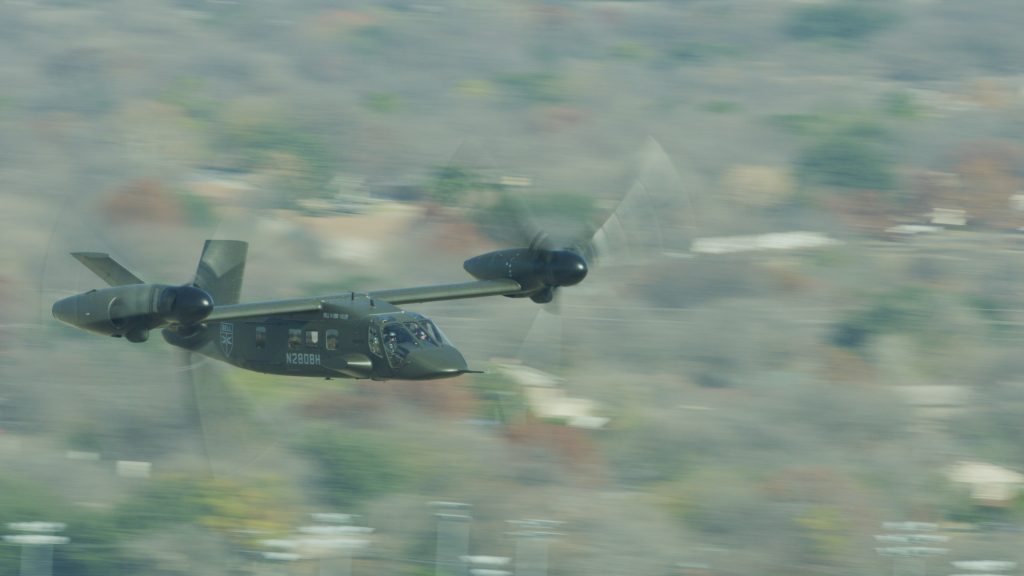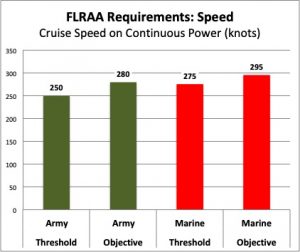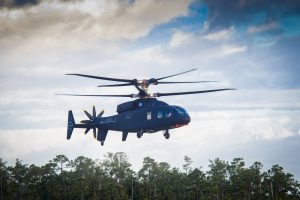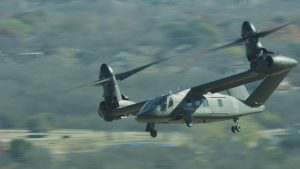NASHVILLE: Bell’s prototype V-280 tiltrotor keeps hitting new milestones as it moves into its second year of test flights. Just ahead of the big annual Army Aviation Association of America (Quad-A) conference here in Nashville, Bell VP Keith Flail told me, they hit a hat trick: “300 — 200 — 100.”
The aircraft has exceeded 300 knots true airspeed — over 345 miles per hour. That’s 55 percent faster than the needle-in-the-red “never exceed speed” (193 knots or 222 mph) of the UH-60L Black Hawk that it’s designed to replace. Now, the prototype is reaching these speeds in short flights without carrying full loads. But 300 knots is already well above not only the Army’s objective for sustained cruise speed (280 knots, the number for which V-280 is named), but also the Marines’ more ambitious objective (295 knots), so those lower speeds should be doable in a real mission.
V-280’s big twin rotors have also turned for over 200 hours, half in ground test and half in flight — which brings us to the final figure, 100 hours of flight test. That last figure is the Bell aircraft’s big advantage over its main rival for the Future Long-Range Assault Aircraft (FLRAA) contract, the Sikorsky-Boeing SB>1 Defiant, which just started flight tests last month.
Arguably, Defiant’s a more innovative design — it uses a pusher propeller (for high speed flight) instead of a tail rotor — but that’s also been its problem. Scaling up Sikorsky’s compound helicopter technology from the award-winning X2 test aircraft to the S-97 Raider light scout to the SB>1 midsize transport has proven tricky, particularly manufacturing the long, ultra-rigid rotor blades required for high speed. If Defiant works as advertised, however, it should be extremely agile at low speeds and low altitude, something Army aviators prize as they land assault troops or recover casualties under fire.
To compete, Bell is pointedly putting V-280 through its own maneuverability tests.
There’s been “a lot of focus on low-speed agility,” Flail told me. The aircraft has already demonstrated the highest category of handling (level one) in two dimensions, pitch and yaw, and is a few tests away from doing so in the third, roll, as well.
The aircraft’s also tested flying with open doors — also critical to getting troops in or out ASAP — and even done some preparation for fast-roping. “We tossed the fast rope out of the aircraft to make sure we got the response we expected,” Flail told me, and, as expected, the aircraft’s wings largely shielded the rope from the turbulent downwash of the big rotors. (Downwash was a big issue with the earlier and larger V-22 tiltrotor, but Marines manage to fast-rope out of it).
“We didn’t put a guy down the rope yet,” Flail said. That may not happen in the current test program. But, Flail said: “I’d volunteer to do it.”
As important and innovative as the aerodynamics of the V-280 are, however, the electronics are going to be equally crucial — especially since the Army wants it to be able to fly unmanned in at least some missions. Bell plans an initial autonomy test by the end of this year. “There’ll be a safety pilot on board but it will take off, fly a route, and land autonomously,” Flail said, without input from the human.
Bell and aerospace giant Lockheed Martin are also working on the aircraft’s modular open architecture. That’s a set of standardized interfaces meant to allow the Army to plug and play new hardware and software from different vendors as it desires, rather than having to either stick with the original manufacturer for all upgrades (aka vendor lock) or laboriously and awkwardly kludge together incompatible systems from multiple companies. Creating a Modular Open Systems Architecture (MOSA) for all future Army aircraft, not just the Black Hawk replacement, is a major priority for the service’s Future Vertical Lift program.
The V-280’s open architecture is derived from one Lockheed developed for the C-130 turboprop — a very different aircraft, which shows how versatile this kind of system can be. It already meets the Future Airborne Capability Environment (FACE) consortium standard endorsed by the Army, Flail told me; Navy and Air Force standards are similar but not identical.
The Army worked with the Marine Corps and Special Operations Command to put out a formal Request For Information (RFI) on what industry could do, to which Bell submitted its answers last week. Those answers will shape the Request For Proposals (RFP) that officially kicks off the competition — although the first round will be multiple awards for designs, with an actual fly-off between competing aircraft coming later. That gives the Sikorsky-Boeing team and other aviation innovators like AVX a chance to catch up.
China’s new H-20 stealth bomber ‘not really’ a concern for Pentagon, says intel official
“The thing with the H-20 is when you actually look at the system design, it’s probably nowhere near as good as US LO [low observable] platforms, particularly more advanced ones that we have coming down,” said a DoD intelligence official.































